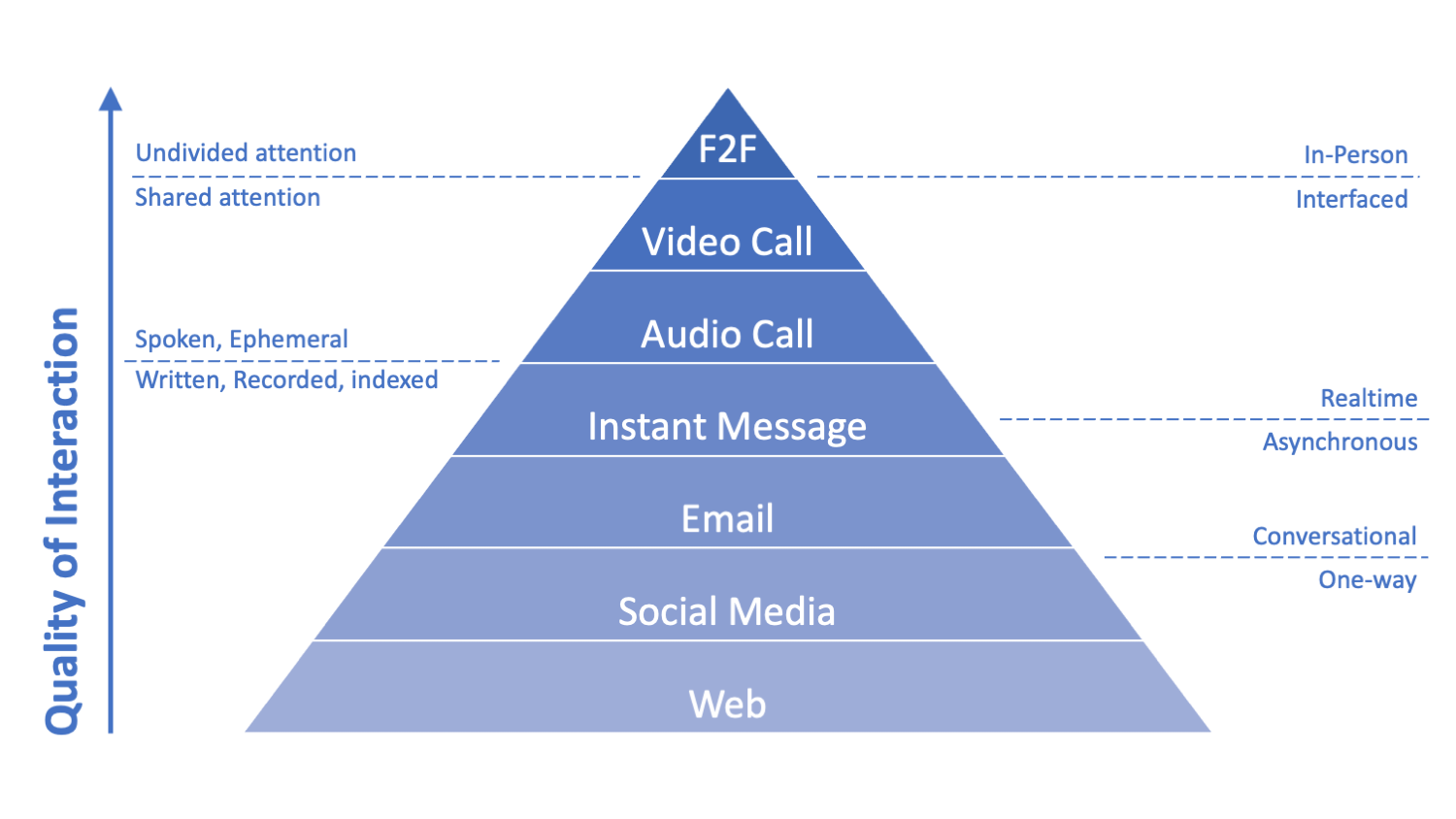Marginal utility of Business Events
As part of the latest UFI GRI study, we asked four additional questions to the panel trying to underpin the marginal utility of face-to-face business events. These questions were based on the findings of an article I’ve published on LinkedIn back in October 2020 called “a comparative study on B2B interaction”
The basic premise of that article was to point out the difference in the quality of interaction experienced at different modes of B2B communication, proposing a hierarchy pyramid with Face-to-face sitting at the top.
We’ve zoomed our current research on the three types of communication at the top: Face-to-Face meeting, Video Call, Audio Call and added Structured networking activities at a virtual event to our question set.
We’ve tested these four types of communication against four business goals which are vital to buyer-seller interactions:
Ease of building business relationships (establishing initial trust)
Ease of conveying a complex message (conducting business negotiation)
Ease of keeping someone’s full attention (staying focussed)
Ease of sharing confidential information (pricing or IP related disclosure)
The panel data consisted of three different key audiences:
Tradeshow exhibitors
Tradeshow visitors
Non-Exhibitors
The results for tradeshow exhibitors and visitors are overwhelmingly in favour of face-to-face and are completely in line with the originally proposed hierarchy. Thus, the hypothesis of the previous research is validated: face-to-face is the unquestionable king of B2B interaction, the next best thing being a video call, followed up by an audio call, whilst structured networking activities at a virtual event trails by a considerable margin.
Furthermore, our methodology allowed us to measure the perceived “ease” of achieving each business goal and thus attach premiums to different modes of communication.
The ease of achieving the four abovementioned business goals show an exponential difference in favour of Face-to-face versus a video call, whilst the marginal utility of a video call is somewhat questionable in comparison against an audio call.
In detail, the premiums attached to face-to-face by exhibitors are:
105% over a video call for Ease of building business relationships
93% over a video call for Ease of conveying a complex message
124% over a video call for Ease of keeping someone’s full attention
85% over a video call for Ease of sharing confidential information
106% over a video call for all goals combined
Same numbers for visitors are even higher:
131% over a video call for Ease of building business relationships
122% over a video call for Ease of conveying a complex message
130% over a video call for Ease of keeping someone’s full attention
179% over a video call for Ease of sharing confidential information
139% over a video call for all goals combined
The picture gets much clearer when we compare face-to-face interaction to Structured networking activities at a virtual event:
For exhibitors the delta between ease of achieving business goals is a striking 308%, suggesting a 4X price premium justification for the same business return for face-to-face events compared to virtual events.
The same study for visitors show a 221% delta, suggesting a 3,2X return on time premium in favour of a face-to-face business event that delivers an identical business return.
These numbers give a good indication on the marginal utility of face-to-face business events and might be a rough guide for pricing adjustments of face-to-face and virtual shows. One thing to keep in consideration is that for virtual shows, the exhibitor does not incur any other cost than the organiser fee and the 4X premium would be allocated against total cost of attendance. Thus, a more realistic comparison would still easily justify a 1,3X price premium. (with the assumption that organiser fees make up 1/3rd of total cost of attendance)
However, for the non-exhibiting audience, the results are not decisive.
First off, the non-exhibitors do not seem to have strong preferences between the different modes of communication. The premiums for this audience vary between 1% and 18% with an average of 7%. Working with Explori’s data team, we’ve come to the conclusion that the non-exhibitor data panel’s margin of error would not justify reaching clear cut conclusions with this little separation between choices.
That being said, one thing is clear, the non-exhibitors do not perceive changes in ease of achieving business goals between the different modes of communications as strongly as the exhibiting and visiting audiences
As a summary, exhibitors and visitors place very high premiums on face-to-face interactions in comparison to video calls, audio calls and structured networking at virtual shows.
Exhibitors are ready to justify a 1,3X-4X price premium to attend face-to-face events, whilst visitors are ready to spend 3,2X more time to achieve the same business result face-to-face.

